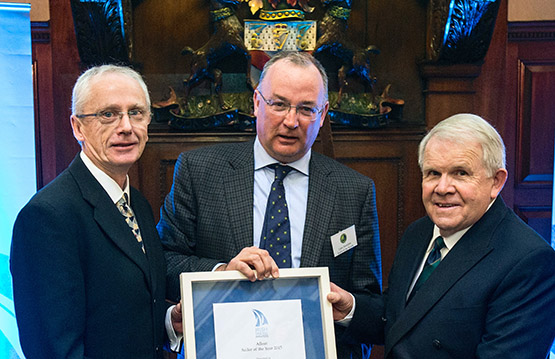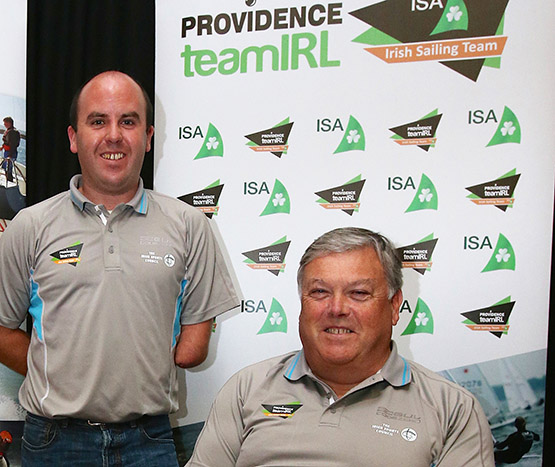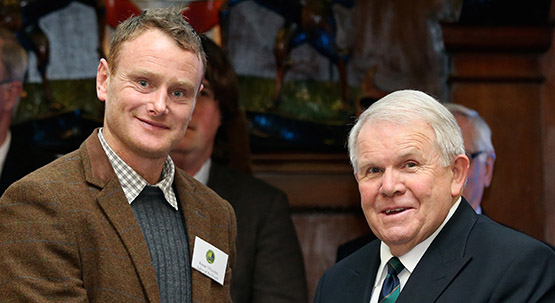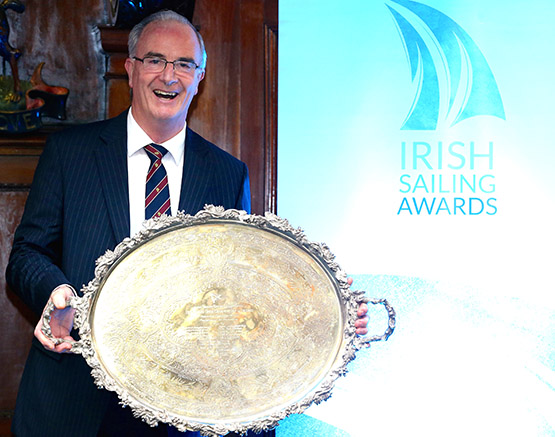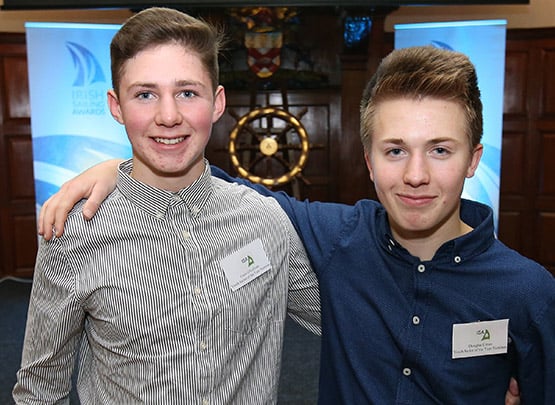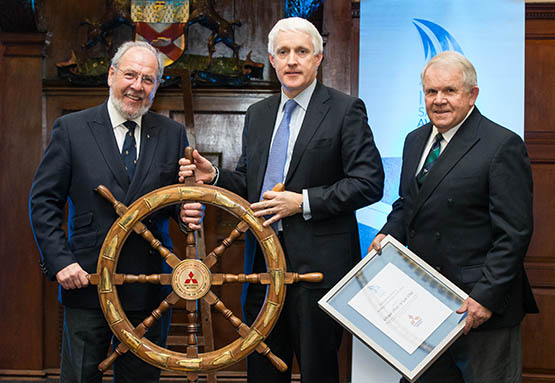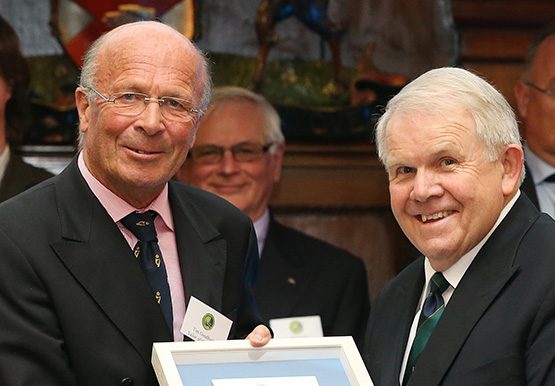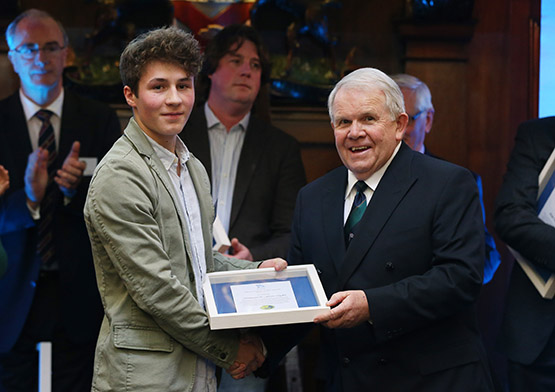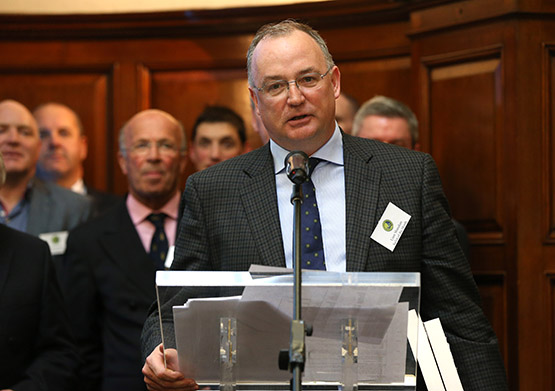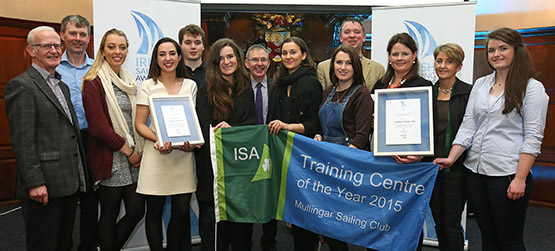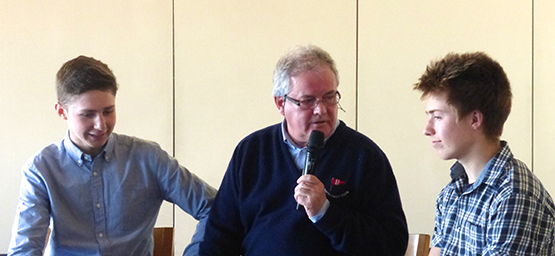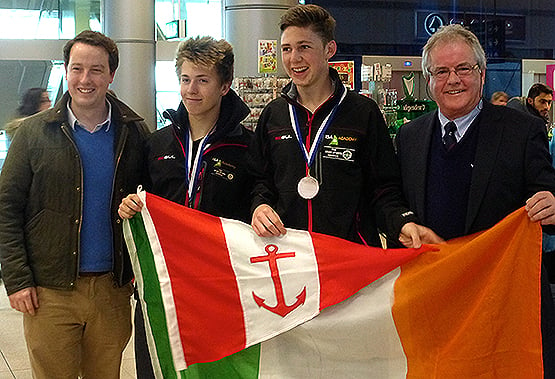Displaying items by tag: Colin O'Sullivan
Irish Sailing Celebrates the Best of the Best
The Irish Sailing Association Annual Awards ceremony undoubtedly conveyed three clearcut messages. The first is that, in global sailing terms, we’re a wet and breezy little island which nevertheless punches way above our weight. The second is that we live comfortably with a long and very distinguished history of recreational sailing which puts most other nations in the shade. And the third is that Ireland is definitely not the greatest place in the world to be a professional sailor. W M Nixon takes a look back at Thursday’s annual prizefest.
Those unfamiliar with the Royal College of Surgeons in Ireland might think it odd that, in just two short years, its splendid College Hall, at the very epicentre of Dublin on Stephens Green, has come to be seen as the most natural focal point for the annual honouring of our top sailors and clubs.
The College Hall in the RCSI provides an ideal setting for the annual gathering for Irish sailing’s national awards.
Sailors talking about sailing. The Awards Ceremony provides a cherished opportunity for sailors from every discipline to shoot the breeze together.
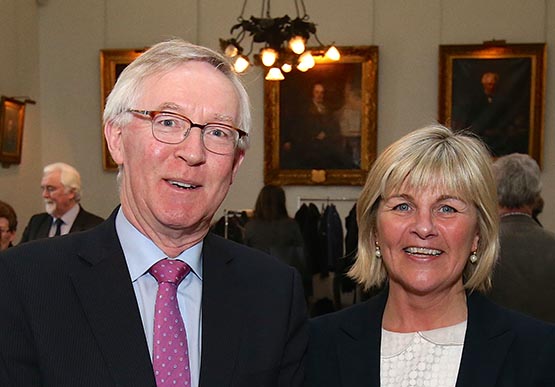
Dragons Den star Bobby Kerr – a sailing man himself – was the lively Master of Ceremonies
But in terms of being a setting which lends itself very positively to such a gathering, College Hall is right on target. It’s a splendid room which is confident with itself without being over the top. It comfortably accommodates the crowd of between 180 and 200 who have come from all over Ireland to celebrate what’s best in our sailing. And as if that weren’t enough, the RCSI has remarkable links with sailing going back more than a hundred years.
John Treacy, CEO of the Sports Council, with Liam Shanahan and ISA President David Lovegrove
So after last year’s first use of the venue, which stemmed from a typically far-sighted suggestion by ISA Board Member Brian Craig, people were keen to go back. And it wasn’t because no-one could think of anywhere better. On the contrary, it was because we’d found that the College of Surgeons is one of those wonderful buildings which make you feel better just from being in it. So in the early days of Spring when we wonder if summer is really going to come at all, a bit of a party in the College of Surgeons is just what the doctor ordered. And as for those doctors and surgeons from the RCSI going sailing, we’ll return to that at the end of this piece. But what of the event itself?
Well, with the Afloat.ie Sailor of the Year award going to a determinedly Corinthian skipper who cheerfully admitted that there’s any amount of professional sailors out there who could probably beat the pants off him, but nevertheless his core interest is offshore racing with family and friends, and if they win within those self-imposed limitations, then so much the better…..There it was, the real voice of Irish sailing, and no mistake.
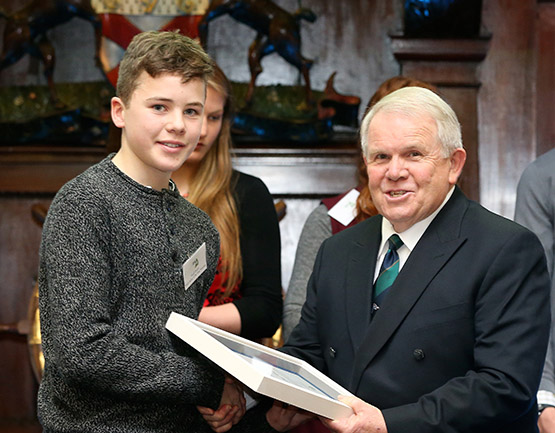
Pierce Purcell of Galway Bay SC with the RIYC’s Michael Boyd, Commodore of the Royal Ocean Racing Club
But what about the clubs through which we go sailing? How can they carry such a wealth of history, and yet be of any contemporary relevance? Here again, the evidence speaks for itself. The new Mitsubishi Motors Sailing Club of the Year has a wonderful history going back to 1831, yet in terms of sailing achievement and voluntary input into the local, regional and national organisation of sailing, it is making a fantastic contribution. And as for its relevance to sailing in the future, independently of the Club of the Year adjudication taking place, this same club was comfortably on its way to being the top ISA Training Establishment in its region, and on the shortlist for the national title too.
Olympian and rising stars – James Espey, Aoife Hopkins and Saskia Tidey
If that’s not an illustration of the way that Irish sailing honours its past while living in the present and looking to the future, then I don’t know what it is. But what’s this third point about Ireland being a cold place for professional sailing? Here again, the assembly in the RCSI was very representative of our Irish sailing population. For sure, there are some very distinguished Irish professional sailors, and there are certainly Irish owners who are prepared to pay the top talents to sail with them. But there’s something about the Irish sailing scene which is inimical to such a setup at home. By all means do it where the weather’s usually benign, and there’s lots of money floating around. But in the Irish climate you sometimes have to be so keen to go sailing despite hostile weather that you just have to rely on nutty amateur crew - the professionals know there’s much better and more reliable pickings elsewhere.
Thus we’ve come to the ironic situation that our top home-based professional sailors are actually our Olympic hopefuls. It’s extraordinary when you think that the modern Olympics were “re-founded” in 1896 in order to celebrate amateur sport, yet now in Ireland just about the only home-based sailors who can be said to be professional are the Olympic aspirants. And if they haven’t accepted that they need a professional approach, then they’re not really at the races at all.
Thus although the friendly Olympian presence of Annalise Murphy, James Espey and Saskia Tidey was much to be welcomed in the very representative throng, generally anyone who was there with any sort of a professional interest in sailing had it as part of a larger business in which actually going sailing is only a small part of the total setup.
Paralympic sailors Ian Costello and John Twomey
Admittedly we did have one Olympian who received an award, John Twomey who took the title in December for his qualification for the Paralympics in September 2016. And he came with added laurels, as on the very day of the ceremony, it had been announced that he and his crew of Ian Costello and Austin O’Carroll had moved up to fifth in the World Rankings. But if you suggested to John Twomey – headed for his 11th Olympiad – that he’s a professional sailor, he’d be convulsed in mirth. Real life is related to an accountancy practice in Kinsale.
So the only other monthly awardee who could remotely be said to be a professional sailor was August winner Ronan O Siochru. who skippered the winning Irish Offshore Sailing boat Desert Star to victory in the 33-strong Sailing Schools Division in the Rolex Fastnet Race 2015. But he’s very definitely running a business - and a very demanding one at that – in which going sailing is only part of it.
Ronan O Siochru with the President
Thus what Thursday’s ceremony was all about was voluntarism and amateur sport, and in case anybody missed the point, it was supposed to be a bit of fun. In this spirit, the greatest trophy in Irish sailing, the might salver for the Helmsman’s Championship, was given an outing. The All Ireland Helmsman’s Championship being an amateurs-only affair, as it is held over an October weekend, inevitably by the time its award ceremony for the salver is shaping up it’s well into Sunday evening. It’s getting dark, and everyone’s tired and wants to go home. So inevitably the handing-over of the historic trophy is a downbeat and somewhat rushed affair.
But as the ISA Annual Awards ceremony is all about handing over prizes with as much ceremony as possible, it was arranged for the salver – which had been hurriedly handed over to successful defender Anthony O’Leary in Dun Laoghaire back in October – to be smuggled out of the O’Leary household down in Crosshaven, secretly taken to Dublin, hidden away in the College of Surgeons, and then formally presented as a surprise extra to the great man after he’d received his Sailor of the Month award for April. He blushed.
Got him! Sailor of the Year 2014 Anthony O’Leary unavoidably missed last year’s awards ceremony, and then in 2015, although though he was Sailor of the Month for April, there were very few people around in October when he successfully defended the Helmsmans Championship Salver. So it was taken secretly to this week’s ceremony, where more than 180 people cheered him to the rafters.
ISA Youth Champions 2015 are Colin O’Sullivan and Doug Elmes, Bronze Medallists in the 420 Worlds.
Before all this, we’d been setting the scene with the ISA Youth Sailors of the Year, who were 420 Worlds Bronze Medallists Douglas Elmes and Colin O’Sullivan, and the ISA Training Centre of the Year, which was Mullingar Sailing Club from Westmeath which headed the Western Region, and overall came in ahead of Foynes YC from the Southern Region and the Royal Irish YC from the Eastern Region.
Katie Johnston of Mullingar Sailing Club with David Lovegrove when MSC was announced as ISA Training Centre 2015.
The new Mitsubishi Motors Sailing Club of the Year is the Royal Irish YC – Commodore James Horan with Billy Riordan of Mitsubishi Motors and David Lovegrove.
But for the RIYC Commodore James Horan, the good news was only beginning, as his club was then announced as the new Mitsubishi Motors Sailing Club of the Year for a host of excellent reasons. We’ll list them in more detail here on Afloat.ie in due course when the traditional handing-over ceremony for the old ship’s wheel trophy is held in the RIYC clubhouse later in the Spring. But meanwhile on Thursday we saw ample reason for it, as two of the Sailor of the Month awards went to very active RIYC members, George Sisk and Tim Goodbody.
July Sailor of the Month George Sisk with the ISA President
Dun Laoghaire Regatta Week 2015 Chairman, Fastnet Race 1987 overall winner, and multiple champion Tim Goodbody was Sailor of the Month in November
Youngest cruising award winner was Fergus Ogden, who in June and July sailed round Ireland with his brother in an open Drascombe Lugger.
Then came the Sailor of the Year announcement. Anyone who was following the voting in the Afloat.ie poll will know it was running very close. But as the poll results are only a quarter of the adjudication process, it was just a couple of days ahead of the awards ceremony when the judges finally made their decision. They came down in favour of Liam Shanahan both for his wonderful and very sporting victory in the Dun Laoghaire to Dingle Race with his family’s J/109 Ruth, and his subsequent success in retaining the Irish Sea Annual Championship title.
His modest acceptance speech was, in effect, a manifesto on behalf of all Irish amateur sailors, and particularly family sailors. The Shanahans are one remarkable sailing tribe right through three generations. And as for that win in the Dun Laoghaire to Dingle Race – well, it was beautiful sailing. Some sailing races are won by brutal slugging. Some are won by sheer cunning. Some inshore races are even won by dirty sailing, and it’s within the rules even if it does the image of our sport no good at all. But some race wins are simply beautiful sailing. And Ruth’s success in Dingle was definitely in that category.
After receiving his award, Liam Shanahan briefly but eloquently outlines his philosophy of sailing
So the ceremony on Thursday concluded with this celebration of the best in Irish sailing, and it chimed well with the mood of the moment and the location, as the current President of the RCSI is Declan Magee who sails from Dun Laoghaire, and he was most welcome at the party and naturally thanked for the use of the hall……
Then as we exited the College Hall, the first doorway we passed was the Sir Thomas Myles Room. He was RCSI President 1900-1902, a wonderful surgeon and a man of prodigious energy who boxed to championship level, and adored sailing. A Home Ruler of Limerick origins. he made his auxiliary ketch Chotah available to take the guns off Conor O’Brien’s Kelpie during the Asgard gun-running of 1914, and landed them in Kilcoole in County Wicklow. And though he was immediately made a Colonel and head of British army surgical services in Ireland on the outbreak of the Great War of 1914-18, he also saw to it that hidden rooms in the major Dublin hospitals under his control were available to treat wounded rebels, indeed anyone who was wounded, during the Rising of 1916.
Builders of the future – the team from Mullingar Sailing Club, ISA Training centre 2015
More recently, a leading sailing figure with links to sailing is Michael O’Rahilly who, when he became a student at RCSI at the end of the 2950s, found that the RCSI Sailing Club consisted of just one neglected Firefly dinghy. By the time he graduated in 1963, he was Club Captain, RCSISC had three Fireflies in top racing condition, and they were the Irish university champions.
Subsequently he went in to play a leading role in Dublin Bay SC, and was the Commodore for the DBSC Centenary in 1984. He follows in a notable RCSI tradition of sailing and working voluntarily for our sport, as an earlier top sailor in the college had been Jimmy Mooney who played a key role in the development of Irish dinghy sailing, and then went on to be our top Dragon sailor for many years, winning the Edinburgh Cup and representing Ireland in the Olympics.
Before Jimmy Mooney another noted character in the RCSI sailing scene was Rory O’Hanlon, who became a noted figure in offshore racing – he won a cup in the 1971 Fastnet Race – and was further renowned for his long distance cruising exploits.
He was noted as a kindly mentor to young cruising hopefuls, gently giving encouragement which could make all the difference to a nervous skipper. One such beginner, who later went on to great achievements, nervously went to Rory O’Hanlon to ask how best he should approach his first major voyage, north towards the Arctic in a little 26-footer.
“Sure, you just keep on sailing, and you’ll get there” said Rory. “Just keep on sailing, that’s all there is to it”. Just keep on sailing. It’s sensible advice. It resonated round College Hall in the RCSI on Thursday afternoon. We should all heed it.
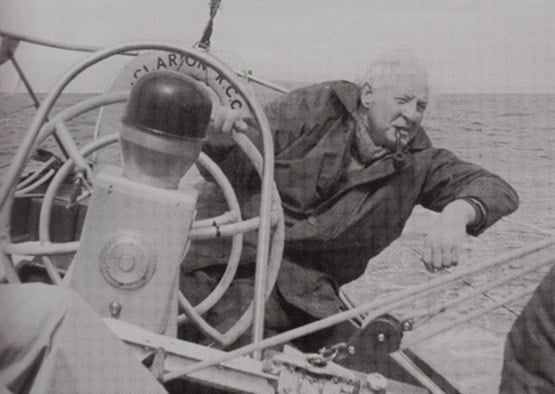
“Just keep on sailing, and you’ll get there”. The late Rory O’Hanlon at the helm of his S & S 43 Clarion with which he won the Philip Whitehead Cup in the 1971 Fastnet Race, and also cruised on long voyages. While a student at the Royal College of Surgeons in Ireland, he was active in the sailing club.
See also: Sailing Awards slideshow
Sailors of the Month – January
In Irish sailing, January is far and away the longest month. Publishing schedules for the printed Afloat Annual mean that December’s Afloat.ie “Sailor of the Month” has to be announced on December 15th. So as though January weren’t quite long enough already, we just go right ahead and extend it to six weeks…….
But the thought that January, however long, isn’t a sailing month in Ireland has been well and truly turned on its head. In all, we have three sailors who have made the standard between December 15th and January 31st, and they well represent the diversity of our sailing scene.
JANUARY SAILOR OF THE MONTH – ENDA O'COINEEN
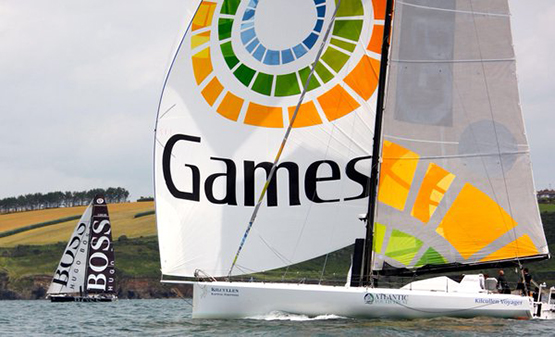
Enda O’Coineen’s Kilcullen Voyager match racing with Alex Thompson’s Hugo Boss in Cork Harbour
In the countdown to Christmas, the thoughts of many in the Irish sailing community weren’t on the usual festive fare. At least parts of their minds were in mid-Atlantic where Enda O'Coineen, arguably Galway’s most stubborn sailor, was battling against the odds in an Open 60 race from St Lucia in the Caribbean to La Foret near Concarneau in Brittany.
“Against the odds” scarcely does the situation justice. Everything seemed to be stacked against him. He’d started a clear day after the rest of the fleet while a mechanical problem was being sorted, but then Kilcullen Voyager and her indomitable skipper found their mojo and fairly streaked across the ocean.
With a mighty leap, our hero freed himself….. It became a race of attrition, with others falling by the wayside through damage or injury. But the Galway boat just kept getting better and better. And they didn’t merely record a respectable finish. They placed third. A podium place. The perfect Christmas present.

It’s Christmas and the celebrations have started as Enda O’Coineen closes in for third place at La Foret
JANUARY YOUTH SAILORS OF THE MONTH – DOUGLAS ELMES AND COLIN O’SULLIVAN
Ireland’s youth sailing programme for 2016 got off to a rocket-assisted start with Doug Elmes (17) and Colin O’Sullivan (16) winning the bronze in the 420 Worlds 2015 in the final hours of the old year at Langkawi in Malaysia.
Sailing conditions were brilliant with good breezes and sunny warm weather. However, a delay in the delivery of the allocated fleet of new boats meant that the practice race was the first time any of the boats had been sailed. But the technological expertise of helmsman Doug Elmes gave the Irish challenge an edge in the race against time to get the boats ready, and though their campaign had its ups and downs, overall it was an impressively cool performance by a team who knew how to put on the pressure and make the right calls when it really mattered.
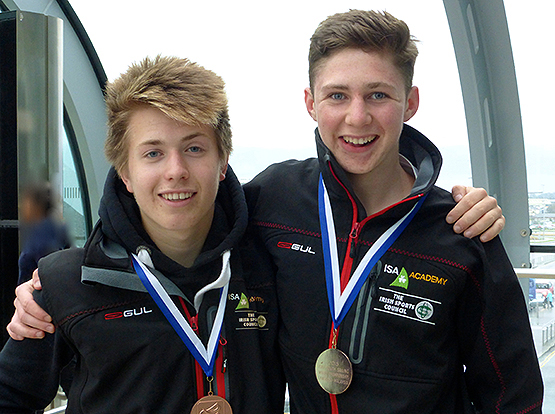
Doug Elmes and Colin O’Sullivan on their return to Dublin Airport with the Bronze medals. Photo: W M Nixon

Sailing conditions were perfect in Malaysia in late Decemberm and the Irish duo revelled in it. Photo: Ross Killian
Elmes is from Kilkenny while O’Sullivan is from Malahide, but it’s the International 420 class’s focal point of Howth YC, with coach Graeme Grant giving the two an extra edge, which had them set up and ready to go to the worlds with ISA Coach Ross Killian.
They had the traditional heroes’ return at Dublin Airport a few days into the New Year, and the weekend saw Howth YC laying on the celebrations with new Commodore Berchmans Gannon putting the medallists through an entertaining question and answer session which set this remarkable success into its proper perspective.
The secrets revealed…..Colin O’Sullivan and Doug Elmes in an entertaining Q & A session with HYC Commodore Berchmans Gannon at the party in the club to celebrate their success. Photo: W M Nixon
How Ireland Won Bronze At the Youth Sailing Worlds
As a vehicle sport dominated by weather conditions, sailing can be difficult enough to explain to the outside world. But when you factor in the constantly changing situation which is youth sailing, where crew dynamics of size, weight and attitude can change with bewildering rapidity, it becomes very complex indeed.
Yet despite the inevitable fluidity, Ireland has long had a vibrant youth sailing scene. And it’s on a roll right now, with the Irish crew of Doug Elmes and Colin O’Sullivan returning this week from the Youth Worlds on the other side of the planet with a Bronze Medal in the 420, while the bonus is that all of the team of four came home from the championship with very solid performances recorded. Liam Glynn returned with 15th out of a fleet of 66 in the Laser Radial Boys, while Aisling Keller was tenth out of 55, also in Laser Radial. W M Nixon tries to capture the mood of the moment, and the machinations behind the 420 crew’s special success.
It could well be that there was only a window of opportunity of maybe six months or even less in which Doug Elmes of Kilkenny and Colin O’Sullivan of Malahide could have been realistically in the frame for a podium place racing the 420 in the Youth Sailing World at Langkawi in Malaysia in the final week of 2015.
The 420 is a gallant little boat, but young sailors outgrow them very quickly. And then before you know it, they’re too old anyway. Elmes, who is now 17, and O’Sullivan, who will become 17 in March, have known each other, and got on well together, since they first met while racing Optimists when aged eleven. But it wasn’t automatic that they should team up to sail 420s, instead of choosing the usual solo junior sailing career path of going on to maybe a year or two in Toppers, and then on into the Laser.
Sailing pundits bewail the fact that our junior sailing is dominated by single-handed boats. But the logistics of campaigning a two-person boat on the national and international circuit at junior level are extremely challenging. The most basic problem is that neither crewmember will have a driving licence. Thus they’re totally reliant on family or organisational support for boat movement, and in the end it almost invariably means that two families will be totally involved.
The level of mutual goodwill required across the generations and between at least two households is extremely high, so it’s not surprising that ISA Coach Ross Killian – he marks ten years as a fulltime sailing coach this year – reckons that a realistic figure for the Irish 420 fleet with genuine potential hovers around the 15 mark, and the going is good when the number of serious participants gets up to 20 boats.
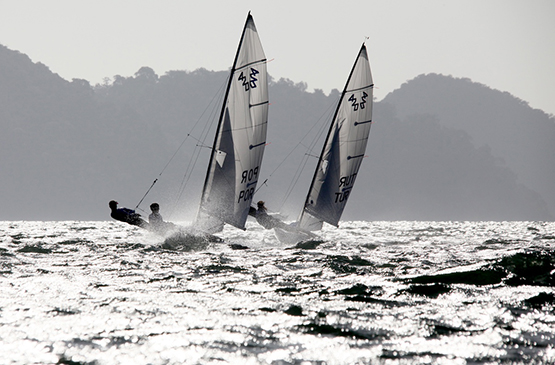
A sailing paradise. The Portuguese and Turkish crews revelling in the perfect 420 sailing conditions at Langkawi.

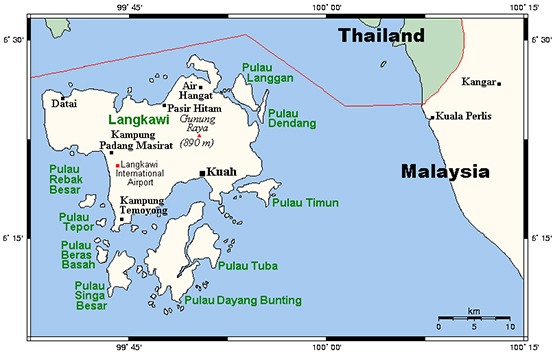
The paradise island provided one problem - getting the boats delivered there had a significant “Just In Time” aspect.
In such a small fleet, inevitably the volunteer administrative work will fall to a few. You get a notion of the compact size of the national operation when you realize that the Irish President is John Elmes of Waterford Harbour SC in Dunmore East, who also happens to be Doug Elmes’ father, while the Class Secretary is Joan O’Sullivan of Malahide who – you’ve guessed it – is Colin O’Sullivan’s mum.
Yet as regular Afloat.ie watchers will be well aware, on Tuesday when the successful team returned to a rapturous welcome in Dublin Airport, the 420 crew found themselves immediately wrapped in the tricolour and the Howth YC burgee, and it’s in the Howth club tomorrow that they’ll be officially welcomed home.
This neatly illustrates the fact that the Irish 420 focal point is a moveable feast. For now at any rate, it’s Howth which happens to be providing the national centre. It is currently coming up with the numbers, and in club coach Graeme Grant it has one very talented individual who inspires the young people to reach the level at which they can be taken under Ross Killian’s wing for the international circuit.
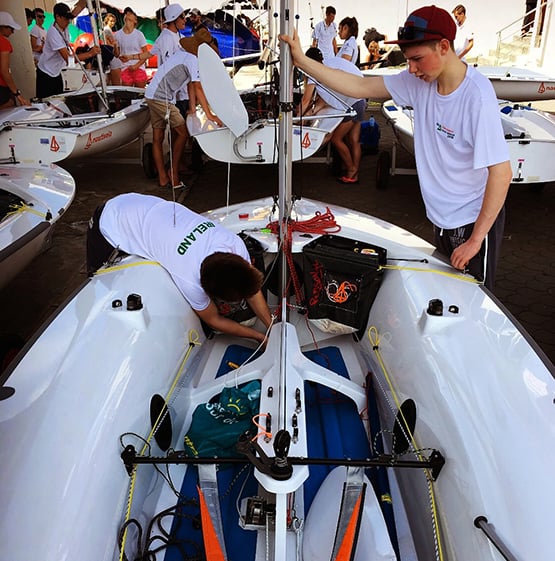
Colin O’Sullivan holds the mast in place as the 420s are rigged and Doug Elmes turns his skills to sorting a technical problem on the boat, which was delivered to the venue at the last moment. Photo: Ross Killian
But it’s a matter of catching the talent when all the stars have the potential to be in alignment, and in the final analysis it’s the young crews themselves who have to show the spark that will be fanned into the flame of success.
Of the successful crew, it was Colin O’Sullivan who first felt the 420 urge. He remembers it very well. He was thirteen-and-a-half at the time, and though he could have had another couple of years with the Optimists, he was growing tall, and so he got involved with 420 sailing, crewing for Ewan McMahon of Howth.
Meanwhile Doug Elmes – who had been concentrating on sailing Optimists at Crosshaven with the RCYC - was soon feeling the same way, and he in turn teamed up to move on to 420 racing with Bill Staunton of Skerries, which tells us something of the truly national nature of Optimist racing.
But when we look at the 420 in detail, it’s to realise that while she’s a very serviceable little boat, the fact that she’s precisely and only 4.2 metres long makes it inevitable that with today’s bigger and faster-growing youngsters, their 420 compatibility period can be very brief indeed, and they have to keep an eye out for potential new crewmates.
Thus when MacMahon and Staunton outgrew the 420, Elmes and O’Sullivan decided to become a crew, and their debut together was at Wexford in September 2014. They’ve been fine-tuning their act ever since, with the busy little class at Howth providing the stage, and they make for a very balanced duo in a boat which is central to world youth sailing.
The virtue of the 420 is that she’s as small and economical as you can get while still having the crew on a trapeze. The boat has been around for more than half a century now, having been designed by Christian Maury to a specification devised by the chief instructors at a sailing school in southwest France. But as she’s one of those boats that looks much better when fully alive and sailing well than she does on the plans, it took a long time in the 1970s before anyone in Ireland would accept the contention, put forward by Sean Clune of the National YC, that the 420 was the only way to go for Irish junior sailing.
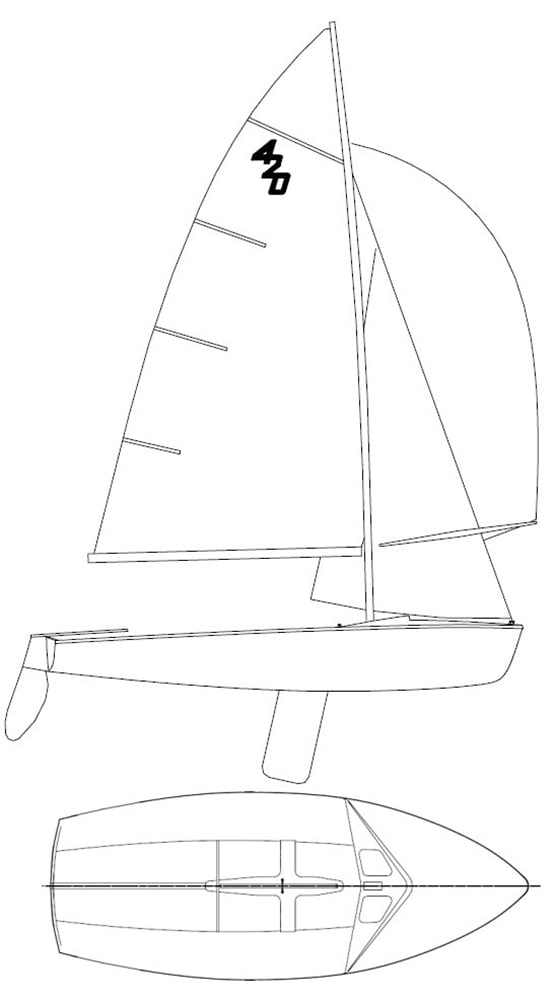
The International 420 is one of those boats which looks better when she’s sailing (below) than she does on the plans (above)

But for those young people who wanted a boat which was minimum hassle to maintain yet providing a proper grown-up sailing experience, the 420 was the future here and now, and it has the advantage of being family-friendly in that, though you’ll need the help of your folks to get the boat to a championship destination, they won’t have to shell out on a 4X4 for a towing vehicle, while it has long been a class tradition that at major international events, the host nation has to provide boats.
So all you have to do is provide the talent and the dedication……Well, there’s more to it than that, of course. But for now, let’s just celebrate the fact that a young sailor from Ireland’s only significant inland town which is not an official waterways port, teamed up moreover with another young sailor who learned his skills on the unique Broadmeadow Water at Malahide, has done the business on the sunny seas of southeast Asia with coolness and style.
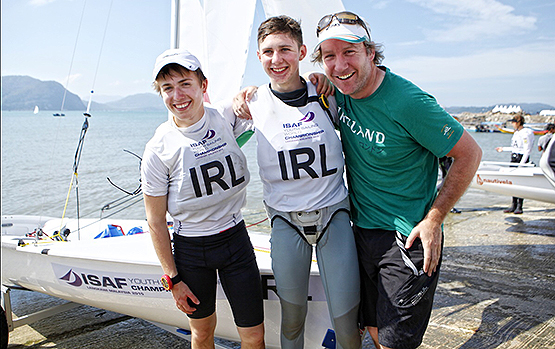
The job done – with their Bronze Medal secured, Doug & Colin get together with coach Ross Killian.
It was classic stuff. As Graeme Grant says of their development: “They have been always improving results and skills through dedication and hard work”. And as Ross Killian attests: “They’re just so cool under pressure, and they balance each other”.
As Colin O’Sullivan loyally asserts, it’s Doug Elmes who is the techno-genius. They arrived in the island of Langkawi to find paradise and perfect sailing conditions – but no boats. There’d been a foul-up in the fleet delivery schedule. The boats arrived at the last minute, so the trial race was the very first sail. But Doug was in his element putting it all together, and their boat was as race prepared as any in the fleet.
As the series progressed, it came down to the wire for the Bronze Medal between Ireland and Australia. In the crucial race, it was the Australian coach who commented to Ross Killian on the stylish coolness of the Irish crew, and watched in open-mouthed admiration as Elmes carried off a mark-rounding with such skill that he picked up three places at a stroke.
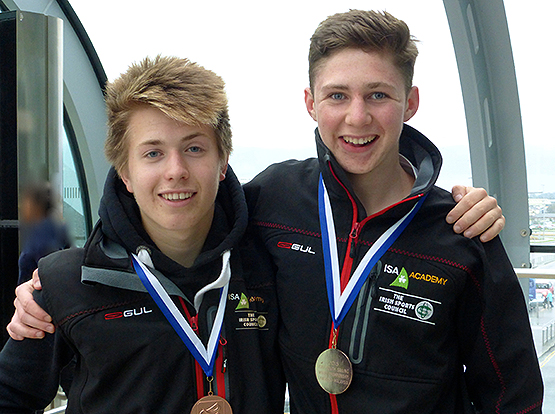
Thereafter, the commentators on the shared coach-boat were favourably impressed by the way the Irish kept the race and their place under quiet yet total control, avoiding the temptation to throw everything away by being unnecessarily greedy.
The day after their return to Ireland, we spoke with Colin O’Sullivan after he’d done some serious catching-up on sleep, yet with typical dedication had dragged himself out into the winter night for his routine session at the gym. The big question with a crew of two is how much they talk during a race. The answer in this case is that since teaming up less than 18 months ago, the Elmes-O’Sullivan crew have upped the talk level with every event, yet it has become more focused each time out. “At Langkawi, we were exchanging information all the time, the talk was constant” says O’Sullivan with a chuckle, “but you definitely wouldn’t call it chat”.
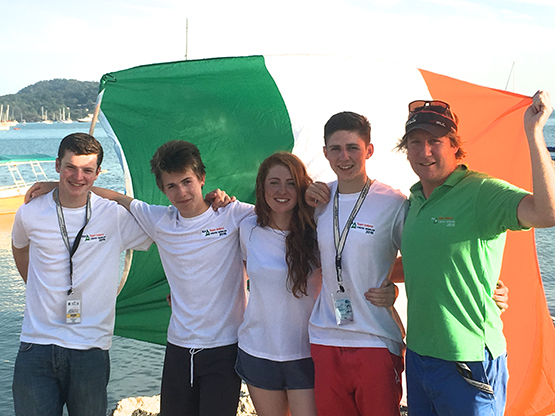
At the conclusion of a good Youth Worlds for Ireland are (left to right) Liam Glynn, Doug Elmes, Aisling Keller, Colin O’Sullivan and Ross Killian.
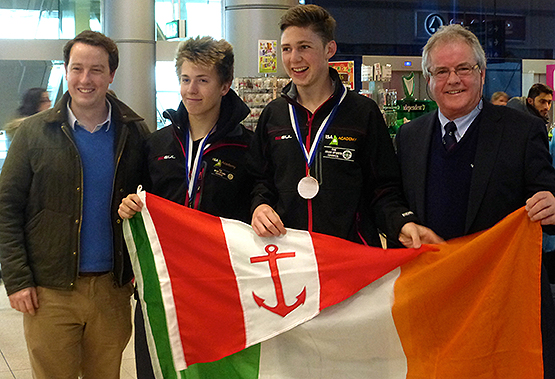
Ireland’s Youth Sailing Team Returns Home With Bronze Medal
The traditional midwinter festive air of Dublin Airport returned briefly but vividly today when Ireland’s team in the Youth Sailing Worlds came home in triumph from Langkawi in Malaysia bearing the Bronze Medal won in the International 420 by Douglas Elmes (17) and Colin O’Sullivan (16).
There to provide a rapturous welcome were family and friends, together with Howth YC Commodore Berchmans Gannon and HYC Honorary PR Officer Ross MacDonald. For although Elmes is from Kilkenny and started his sailing at Dunmore East, while O’Sullivan is from Malahide, it was through the intensely-focused 420 class in Howth, under the inspired tutelage of coach Graeme Grant, that the two have made their way towards a podium place in the Worlds.
The ISA Academy’s project to send a team to the Youth Worlds has paid off handsomely, for in addition to the Bronze Medal in the 420, Aisling Keller came home with tenth place overall in the fleet of 50 in the Laser Radial Girls, while Liam Glynn was 15th in the 66-strong Laser Radial Boys.
W M Nixon’s Sailing on Saturday blog this weekend will analyse the story behind the medal success, and there’ll be a special reception for the medallists and their families in Howth YC on Sunday.
“You’ve done us proud….” Welcoming home the Bronze Medallists at Dublin Airport are (left to right) Ross MacDonald (Howth YC), Douglas Elmes & Colin O’Sullivan, and Berchmans Gannon (Commodore, Howth YC). Photo: W M Nixon
Douglas Elmes & Colin O'Sullivan Win World Youth Bronze
Howth Yacht Club's Douglas Elmes (17) and Colin O'Sullivan (16) have won a bronze medal for Ireland at the World Youth Sailing Championships that concluded in Malaysia today. The Irish National Champions sailed a consistent series in the 420 dinghy that saw them edge out a top Australian pairing in the closing stage of the nine race regatta to take Ireland's first double–handed world youth medal in 19 years.
Irish celebrations started as soon as the boys hit the beach in Langkawi to toast the result that equals the ISAF double handed bronze won by Laura Dillon and Ciara Peelo in the Laser II dinghy two decades ago. In another boost for Irish youth sailing, it is the third youth medal in four years for Ireland with Laser sailors Finn Lynch and Seafra Guilfoyle winning world silver in 2012 and 2014 respectively.
Strong breezes swept the pair to the top of the fleet at the early stages in the competition, stunning some of their international competition but there was no surprise in the Irish camp when the on form duo moved into third overall on Wednesday after four races. They leap–frogged last year's Singaporean gold medallist Singapore's Jia Yi Loh, now sailing with Matthew Lau, in fourth to include a well earned win in race three. Although they dropped to fourth and on equal points wih Brazil in race seven, a race eight disqualification for the Aussies, Alec Brodie and Xavier Winston Smith, handed a bronze opportunity – and a possible silver too – to Ireland.
In the end, Gold went to American's Will Logue and Bram Brakman with a race to spare, the silver medal went to Brazil's Leonardo Lombardi and Rodrigo Luz, as they had a third in the last race, to finish on 37 points.
Elmes and O'Sullivan held off a late fight back in race nine from the Australian's and Argentina's Felipe Martinez, Autin Diniz and Ivan Aranguren, to claim bronze on 46 points. The Australian's scored a ninth and finished on 48 points and the Argentinian's took a bullet for 49 points. Elmes and O'Sullivan (below) finished 11th in the final race but had some breathing space going into the day, just enough to ensure Ireland was not going to be denied its long overdue double–handed medal.
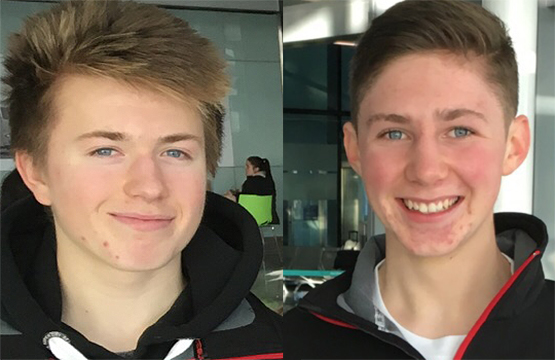 Douglas Elmes (left) and Colin O'Sullivan World Youth Sailing Bronze medal winners in the 420 dinghy
Douglas Elmes (left) and Colin O'Sullivan World Youth Sailing Bronze medal winners in the 420 dinghy
As David O'Brien reported in the Irish Times reported last Friday, the Irish Leaving certificate students left for Malaysia on a high note this month when they won an end of season UK regatta to put them in top gear ahead of their Youth Worlds debut. It's not the only season success either; Elmes from Kilkenny and O'Sullivan from Malahide, now sailing together for 15 months, made a clean sweep of the Irish calendar, taking all four regional championships.
The former Optimist sailors also took a strong fifth place at Kiel week international regatta in Germany in June and – despite a broken toe later in the Summer – made the international qualification for this week's Youth Worlds in Japan at the 420 Worlds.
Podium for the 420 boys #YouthSailing #2015YouthWorlds pic.twitter.com/aNNz2ViB5D
— ISAF Youth Worlds (@youthworlds) January 3, 2016
In addition to the 420 success, Irish sailors Aisling Keller and Liam Glynn had excellent results in the stiffest of competitions. In the Girls Laser Radial class, Lough Derg's Keller finished strongly to earn a 10th place overall - the best result in a generation of youth females. Glynn finished the event strongly and jumped back into the top 15.
The sailors are now preparing for the closing ceremony in Langkawi. Spot the Irish team top left in this video from the venue below:
Final take! #YouthSailing pic.twitter.com/8dhStreAOW
— ISAF Youth Worlds (@youthworlds) January 3, 2016
Youth Worlds Update: Elmes & O'Sullivan Move Into Third, Australian Boys Disqualified From Race 8
Irish 420 pairing Douglas Elmes and Colin O'Sullivan have moved into third place at the World Youth Sailing Championships and are within a single point of the silver medal after Australians were sensationally disqualified from race eight this afternoon in Malaysia.
As a result the Howth Yacht Club duo have it all to play for in tomorrow's final race where Ireland could yet win silver or bronze but equally could lose out in a cliff–hanger race nine as the Australian boys, Alec Brodie and Xavier Winston Smith, are only four points adrift in fourth place.
Irish 420 Boys Lying Third at ISAF Youth Worlds
Irish 420 youth sailors Douglas Elmes and Colin O'Sullivan have moved into third place overall after day two of the Youth Sailing World Championships in Malaysia.
It was a perfect day for some of the early starters as the big breeze was back in Langkawi, Malaysia. Four races have now been sailed and the Howth Yacht Club crew took a well earned win in race three of their 33–boat fleet. With fourteen points scored, Elmes and O'Sullivan are on equal points with Singapore's and Jia Yi Loh and Matthew Lau but only six points off second overall held by Australia's Alec Brodie and Xavier Winston–Smith.
Ballyholme YC's Liam Glynn has dropped out of the top ten of the Laser Radial, but only just, the former Topper World Champion is 11th in his 66 boat fleet. Lough Derg YC's Aisling Keller lies 14th from 53.
Always up and around the top of the boy's 420 are USA's Will Logue and Bram Brakman. With three second places and a discarded third, they can't seem to find that elusive bullet, but lead overall on six points.
The first bullet of the day went to Ireland's Elmes and O'Sullivan who sit in third on 14 points with last year's Youth Worlds gold medallist Singapore's Jia Yi Loh, now sailing with Matthew Lau, in fourth. Loh and Lau had an average day by gold medal standards with a discarded 12th and a sixth place.
So is the weight of a gold weighing on his shoulders? From his demeanour and words, I think not, "I'm sailing with a different crew and we know this place is tricky and the fastest sailor may not necessarily win. It's all about how you play the shifts and anyone here could win, and that's why I think it's taken off some stress."
Singaporean sailors generally have a reputation for excelling in lighter winds due to their build, but Loh isn't letting the strong winds that Langkawi is throwing at them hinder his chances, "We are fine with any winds. In Singapore we get light winds, but then we are on the heavy side so we are fine in strong winds as well."
Picking up the other bullet of the day were Finland's Eklund brothers, Jacob and Anton. With middle order finishes in all their other races, the brothers will hope that the bullet will bring a change in fortunes and is a sign of things to come.
There have been a number of technical glitches at the 'incredibly warm' event, according to Afloat.ie insiders. For example, the supplied 420 fleets didn't get to sail on the prescribed training day as all the required equipment hadn't arrived. Likewsie the SL16s (no Irish affected) didn't race on the first day as they waited for equipment.
Click here to go to the results sheets
Royal Cork & Howth 420 Youth Sailing Duo Take Fourth In Spain
#420 – Irish youth 420 dinghy sailors Douglas Elmes (RCYC) and Colin O'Sullivan (HYC) took fourth place in the International Grand Prix Vila de Blanes this week, in Blanes, Spain.
The event was sailed in the 420, 29er and Europa classes, with 26 entries from Spain, Russia, Poland, Germany and Ireland competing in the 420 class.
The regatta was excellently run, with racing beginning at 9am most days to take advantage of the land breeze, which tended to die at midday, with sea breezes of 5-8 knots kicking in mid-afternoon. A full schedule of 10 races was completed with one discard in the series.
Elmes and O'Sullivan progressed gradually through the fleet, and a win in R10 on the last day secured fourth place overall, with top three going to Germany, Poland and Spain.
Final results downloadable below.
































